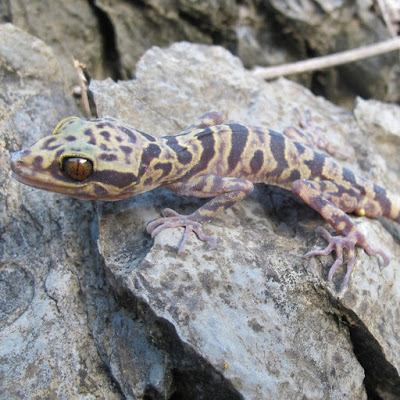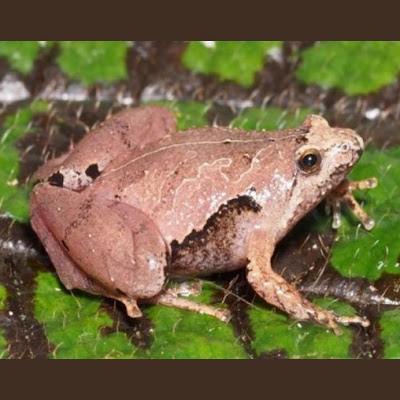[Most Recent Entries] [Calendar View]
Monday, January 14th, 2019
| Time | Event | ||||
| 4:16a | [Herpetology • 2019] Cyrtodactylus taybacensis • A New Species of Cyrtodactylus (Squamata: Gekkonidae) from northwestern Vietnam
Abstract We describe a new species of Cyrtodactylus on the basis of seven specimens collected from karst forests of Son La and Dien Bien provinces, Vietnam. Cyrtodactylus taybacensis sp. nov. is distinguished from the remaining Indochinese bent-toed geckos by a combination of the following characters: medium size (SVL up to 97.5 mm); dorsal tubercles in 13–16 irregular rows; ventral scale rows 30–38; ventrolateral folds present without interspersed tubercles; each thigh with 11–13 enlarged femoral scales; femoral pores absent in males and females; precloacal pores 11–13 in males, five or 15 pitted scales in females, in a continuous row; postcloacal tubercles two or three; lamellae under toe IV 16–20; subcaudal scales transversely enlarged; dorsal head with dark brown marking, oval, triangle and arched shape; five brown dorsal bands between limb insertions. In phylogenetic analyses, the new species is recovered as a member of the Cyrtodactylus wayakonei species group, and strongly supported as the sister taxon of C. cf. bichnganae from Son La City in all analyses. Keywords: Reptilia, Cyrtodactylus taybacensis sp. nov., molecular phylogeny, taxonomy, Dien Bien, Son La
Cyrtodactylus taybacensis sp. nov. Etymology. Specific epithet “taybacensis” is a toponym in reference to the type locality of the species, meaning “from northwestern region”. For the common names we suggest Taybac Bent-toed Gecko (English) and Thạch sùng ngón tây bắc (Vietnamese). Anh Van Pham, Minh Duc Le, Thomas Ziegler and Truong Quang Nguyen. 2019. A New Species of Cyrtodactylus (Squamata: Gekkonidae) from northwestern Vietnam. Zootaxa. 4544(3); 360–380. DOI: 10.11646/zootaxa.4544.3.3 | ||||
| 11:52a | [Herpetology • 2018] Microhyla gadjahmadai • A New Species of Microhyla (Anura: Microhylidae) from Sumatra, Indonesia Abstract A new species of frog in the genus Microhyla is described from Sumatra, Indonesia based on molecular and morphological characters. This new species was previously confused with M. achatina, a Javan endemic. This new species is diagnosable from its congeners by possessing a medium size (SVL in adult males 18.20–21.32 mm, in adult females 20.37–25.51 mm), a stout body, a nostril–eyelid length being about half of the snout length, having a single outer palmar tubercle, a tibiotarsal articulation reaching the center of the eye (when the hindlimbs are stretched and adpressed to the body), having finger and toe tips dilated, having the dorsum with medial longitudinal grooves, and excibiting a very thin and short dark stripe on the temporal region above a wider cream stripe, extending from the postorbital area to insertion of forelimb. Additionally, the new species is characterized by possessing relatively little foot webbing. Uncorrected 16S rRNA sequence divergences between the new taxon and sequences for other congeneric species available ranged from 4.8 to 15.0%. Keywords: cryptic species, mitochondrial DNA, phylogeny, taxonomy Microhyla gadjahmadai sp. nov. Synonomy: Microhyla sp. 3: Matsui et al., 2011, p. 168 & 171 Diagnosis. The new species is assigned to Microhyla because of having a small size (SVL < 30 mm), narrow head and mouth, tympanum hidden by skin, maxillary and vomerine teeth absent, and a reduced first finger length (Tschudi,1838, Malkmus et al.,2002). Microhyla gadjahmadai sp. nov. is diagnosable from its congeners by having a medium size (for Microhyla, SVL adult males 18.2–21.3 mm, adult females 20.4–25.5 mm), stout body, a nostril–eyelid length of half the length of the snout, a single outer palmar tubercle, the tibiotarsal articulation reaching the center of eye, finger and toe tips dilated, median longitudinal grooves on dorsum, relatively reduced toe webbing (free of webbing: one and three quarter phalanges on outer surface of second toe, three phalanges on inner and outer surface of third toe, four phalanges on inner and outer surfaces of fourth toe, and two and three quarter phalanges on inner surface of fifth toe), and a thin-short dark temporal stripe over a wider cream stripe, extending from postorbital area to insertion of forelimb. Etymology. The specific epithet honors the military leader and hero Gadjah Mada, who in the fourteenth century unified the whole of the Nusantara (i.e., Malay Archipelago) under the Javanese rule of the Hindu Majapahit Empire. Natural history. Microhyla gadjahmadai sp. nov. is distributed in southern Sumatra, inhabiting from primary forest, secondary forest and open area such as farming area (Bengkulu). The tadpole and advertisement call of this species are still unknown. Range. The new species is curently known from Bengkulu (Rejang Lebong, Bengkulu Utara, and Kepahiang Regency), Lampung (Tanggamus and Lampung Tengah Regency), and South Sumatra (Muara Enim Regency and Pagar Alam City) province with elevation range from 700–1647 m a.s.l. Vestidhia Yunisya Atmaja, Amir Hamidy, Tuty Arisuryanti, Masafumi Matsui and Eric N. Smith. 2018. A New Species of Microhyla (Anura: Microhylidae) from Sumatra, Indonesia. Treubia. 45; 25-46. DOI: 10.14203/treubia.v45i0.3625 | ||||
| 2:15p | [Herpetology • 2019] Fejervarya marathi • A New Species of Fejervarya Bolkay, 1915 (Anura: Dicroglossidae) from the northern Western Ghats Parts of Maharashtra, India
Abstract In the recent past the systematic position and taxonomy of genus Fejervarya, Bolkay is undergoing changes in its systematic position due to fairly good amount of phylogenetic resolution, cryptic morphological characters and lack of systematic sampling for phylogenetic studies across the range of distribution. In our sampling in the northern Western Ghats, we encountered a new lineage sister to the phylogenetic cluster which comprises the 'Rufescens complex'. This new lineage is described here as new species Fejervarya marathi sp. nov. based on distinctness in a combination of morphological characters, genetic distance and geography. The problems in morphological groupings for the Fejervarya frogs of the Western Ghats in the recent studies are discussed with the sub-clade composition based on geography in the phylogenetic tree. Keywords: Amphibia, Cryptic species, Fejervarya, Marathi, northern Western Ghats
Fejervarya marathi sp. nov. Etymology. The specific epithet is derived from the indigenous language "Marathi" which is one of the predominant language used in the northern Western Ghats. The species epithet is treated as noun in apposition to the generic name. Suggested common name 'Marathi Fejervarya frog'. Samadhan Phuge, K.P. Dinesh, Ramnath Andhale, Kalyani Bhakare and Radhakrishna Pandit. 2019. A New Species of Fejervarya Bolkay, 1915 (Anura: Dicroglossidae) from the northern Western Ghats Parts of Maharashtra, India. Zootaxa. 4544(2); 251–268. DOI: 10.11646/zootaxa.4544.2.5 facebook.com/SamadhanPhuge/posts/2005419489513885 |
| << Previous Day |
2019/01/14 [Calendar] |
Next Day >> |








